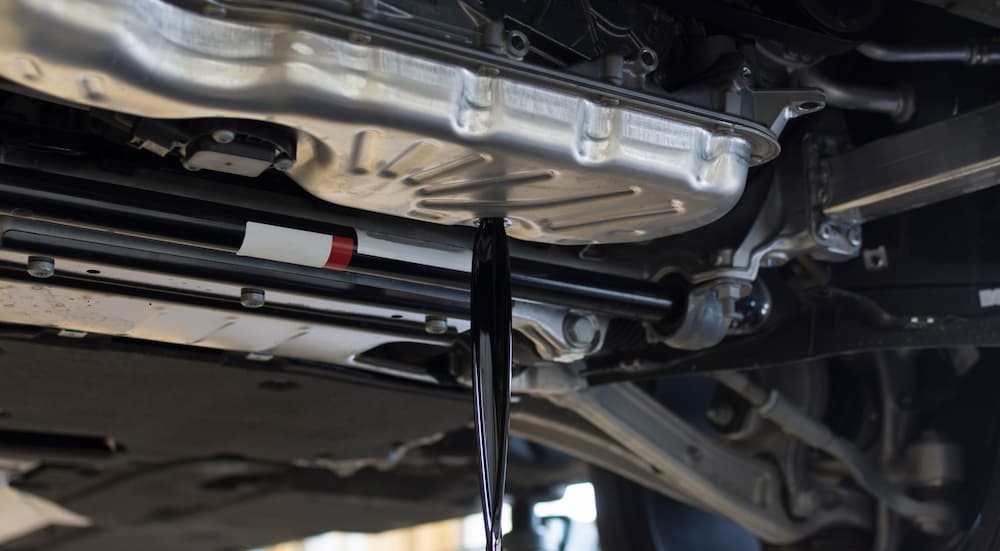Rumors abound when it comes to car care and maintenance tips. While certain nuggets of advice have been passed down from generation to generation, there isn’t always much data to back up these words of wisdom. Take the old engine warm-up tip, for example. Once upon a time, vehicles did genuinely benefit from a little preconditioning, especially on colder days, but advances in automotive engineering mean that today’s models can generally be driven as soon as the engine turns over. Discolored brake fluid was once seen as a clear sign that the system needed to be flushed, but in most cases, the color doesn’t actually indicate an issue or necessitate a replacement.
That brings us to motor oil. There are plenty of misconceptions around this vital fluid, especially when it comes to how often it should be replaced. While it’s generally designed to last longer than you might imagine, the specific schedule really varies by make and model. Every oil change is important when it comes to your vehicle’s long-term health and performance, but some believe that the first oil change is particularly crucial. When a new vehicle arrives at a dealership, it’s usually filled with the same oil that was installed when it first left the factory. Many drivers are a little wary of this original oil, and routinely flush it out and replace it as soon as they take ownership. Is this a necessary part of a normal maintenance routine, or is it just a waste of money? We’ll answer that question and discuss some of the pros and cons of a proactive oil change, and try to shed some light on this common car rumor.
To Flush or Not to Flush
While there’s no clear consensus on the benefits of an early oil change, there’s plenty of anecdotal evidence to go by. Many drivers swear by the practice, claiming that it helps to remove the microscopic metal particles that can shed from the engine’s internal components in a new vehicle. In reality, the oil filter will capture most particles that you’d have to worry about, but an early oil change can provide some valuable peace of mind and help establish a strong vehicle maintenance routine. If you’re really concerned about these early contaminants, you can always send out a sample of your used motor oil for analysis, but that’s going above and beyond what most vehicles require.
There’s also no telling what sort of oil has been used in a vehicle’s engine when it first rolls off the assembly line. Most automakers are going to use a premium blend that’s specifically designed for your specific make and model, but quality does vary, and errors do happen. By performing an early oil change, you can ensure your engine runs on the best possible product. Old habits die hard, and the tradition of replacing factory oil can largely be credited to the below-average quality of vehicles produced between in the 1960s, 70s, and 80,s which were plagued by potential issues. Many became accustomed to switching out the factory oil since their earliest driving days, and have continued to employ to approach despite a general uptick in automotive manufacturing quality.
How Often Should You Change It?
An early change might not be as crucial as some drivers tend to think, but it does raise a good question. How often should you change your oil? We’ll begin by busting one of the biggest oil change myths. Every driver of a certain age remembers the old maxim about changing the oil every 3,000 miles, but that number hasn’t really kept up with the times. Thanks to advances in engine design and oil formulation, today’s motor oil can actually last up to 5,000 miles in the case of a conventional blend.
Those looking to minimize their trips to the lube shop should consider using a synthetic motor oil, which can allow an engine to operate for as long as 7,500 miles between changes thanks to its improved wear and heat fighting properties. Many of today’s vehicles run on a new type of synthetic motor oil, while older models tend to employ a conventional formula. While it’s generally safe to use synthetic in an engine that usually requires conventional motor oil without opening yourself up to any risks, it’s not a two-way street. Using conventional motor oil instead of a synthetic can impact an engine’s efficiency and cause serious damage due to inadequate cooling and cleaning.
Synthetic oil does have advantages in terms of extending the replacement schedule, but the frequency of your oil changes will ultimately be dictated by the owner’s manual. There are plenty of online resources like CarBuyerLabs that’ll help you get the most out of your car, truck, or SUV, but if you’re looking for a step-by-step guide that outlines all the relevant maintenance tasks and when they should be performed, there’s no substitute for the owner’s manual. Many modern vehicles also have built-in service reminders that’ll automatically alert you to an upcoming oil change, but it’s not too hard to keep track of the schedule on your own by saving the receipt from your local lube shop or referencing the sticker that’s affixed to your windshield after an oil change.

Reasons to Change Your Oil Early
If you ask 100 people their opinions about oil changes, you’ll get at least 100 different answers. Here are some of the common reasons people say to change your oil early and often.
Improved Engine Life
The fresher the motor oil is, the better it is at protecting the vital and expensive components that keep your engine running. The constant, contained explosions that occur within an internal combustion engine can generate plenty of heat and friction, but modern motor oil is specially formulated to keep everything running smoothly, no matter how many miles there might be on the odometer. As oil begins to break down, it loses many of its cleaning, cooling, and lubrication properties as heat and oxidation take hold. This can cause premature wear and tear and lead to deposits and sludge that will compromise a vehicle’s performance. While most engines can easily surpass 100,000 miles with few issues, regular oil changes will allow you to keep your vehicle on the road for as long as possible.
More MPG
The lubricating properties of motor oil can have a major impact on a vehicle’s efficiency. Older oil might not keep everything working smoothly, which means the rods, pistons, and other components within the engine have to work just a little bit harder to generate power. This increased friction can easily cause the overall fuel economy to decrease by as much as two or three percent, which is another good reason to stay on top of your oil change regimen. Most of today’s vehicles are able to display your average fuel economy, so if you notice your MPG is starting to slip, it might be time to consider taking your daily driver in for an oil change.
Reasons Not to Change Your Oil Early
Some feel that frequent oil changes are not as necessary as they once were. Here are some of the reasons they give for letting it go just a little bit longer.
The Risk of Using the Wrong Oil
Every time you pull into a lube shop or pop the cap on a fresh quart of motor oil, you risk using the wrong product. While a less experienced driver might think every type of motor oil is created equal, your vehicle’s engine was designed to run on a very specific formula. The exact mixture comes down to a matter of the included additives and viscosity, which is a term that basically describes how thick or thin a particular oil is. A “thinner” oil, like a 5W-20, can flow through the tight cracks and crevices in the engine more easily, while a “thicker” formulation, like a 10W-4,0 will have a harder time penetrating the depths of some motors.
Different engines have different tolerances, clearances, and operating temperatures, which is why it’s so important to always reach for the right formula when completing an oil change if you expect your ride to work its best. Many vehicles actually call for a thinner, lower-weight oil in the winter and a thicker formulation in the warmer summer months. As always, it’s important to check the owner’s manual to ensure you are choosing the right product for your vehicle and the time of year.
Extra Cost
While they might be one of the more affordable maintenance tasks a driver might hope to encounter, a premature oil change can noticeably impact your wallet. A typical oil change using conventional oil will cost you between $35 and $75, while a synthetic swap can run upwards of $65 to $125, depending on the make and model. Shelling out over $100 to replace the oil that came with your vehicle might help when it comes to establishing a strong maintenance routine and setting a schedule, but that money could also be spent on more worthwhile maintenance tasks, optional accessories, or cleaning products that will have just as much of an effect on your ride’s long-term performance and resale value.
Drivers might be able to defray this cost by performing an oil change on their own, but it all depends on their expertise and equipment. An oil change isn’t a terribly tricky task, but it does require a few specialized tools that can quickly add to the cost, such as an oil filter wrench, drain pan, and a jack and jack stands if your vehicle doesn’t have enough ground clearance to shimmy underneath. The oil itself will typically be the most expensive part of the project, especially if your vehicle requires a synthetic blend. Most drivers prefer to opt to outsource the job, but if you’re willing to get a little messy and want to learn a little more about the inner workings of your vehicle, it might be worth making the investment and performing your own oil changes.

Play It Safe With Regular Oil Changes
It’s pretty much impossible to do any damage to your engine by treating it to an early oil change, assuming the procedure is completed correctly. While there’s not a lot of concrete evidence to back up the potential benefits, the only downside is the increased cost, but that’s a small price to pay for the sort of security an early oil change can provide. Many old-school drivers tend to follow a pretty similar oil replacement schedule, swapping out the fluid after the first 500 miles, 2,500 miles, and 5,000 miles thereafter. A more realistic schedule might see a driver replace the oil anywhere between 1,000 and 3,000 miles, but ultimately it’s all up to your discretion and personal preference. While we’ve outlined some of the advantages and disadvantages of early motor oil replacement, every owner should ultimately try to base the decision on their own comfort level. If you’re the type of driver who tends to be a little anxious about performance and longevity, an early oil change could certainly be worthwhile, but it could be seen as a waste of money if you take a more relaxed approach.



